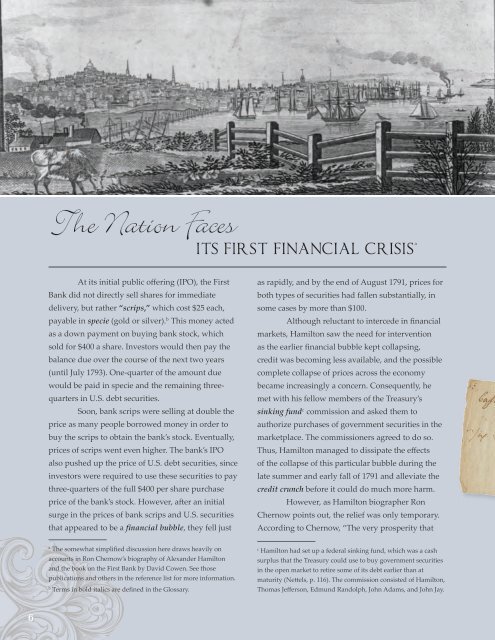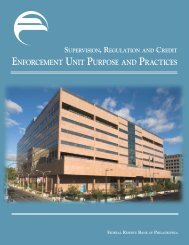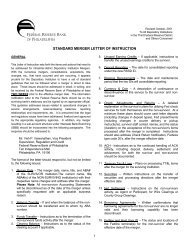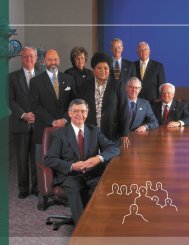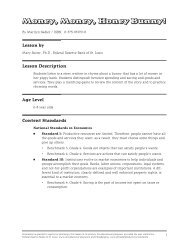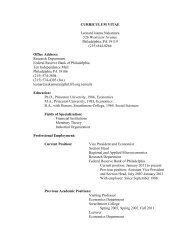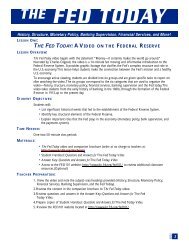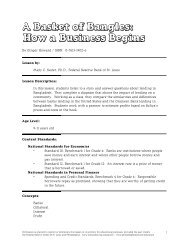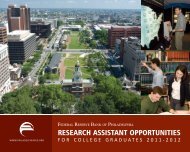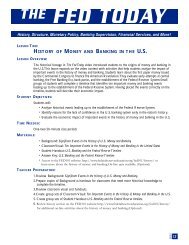The First Bank of the United States - Federal Reserve Bank of ...
The First Bank of the United States - Federal Reserve Bank of ...
The First Bank of the United States - Federal Reserve Bank of ...
Create successful ePaper yourself
Turn your PDF publications into a flip-book with our unique Google optimized e-Paper software.
6<br />
<strong>The</strong> Nation Faces<br />
ITS FIRST FINANCIAL CRISIS a<br />
At its initial public <strong>of</strong>fering (IPO), <strong>the</strong> <strong>First</strong><br />
<strong>Bank</strong> did not directly sell shares for immediate<br />
delivery, but ra<strong>the</strong>r “scrips,” which cost $25 each,<br />
payable in specie (gold or silver). b This money acted<br />
as a down payment on buying bank stock, which<br />
sold for $400 a share. Investors would <strong>the</strong>n pay <strong>the</strong><br />
balance due over <strong>the</strong> course <strong>of</strong> <strong>the</strong> next two years<br />
(until July 1793). One-quarter <strong>of</strong> <strong>the</strong> amount due<br />
would be paid in specie and <strong>the</strong> remaining threequarters<br />
in U.S. debt securities.<br />
Soon, bank scrips were selling at double <strong>the</strong><br />
price as many people borrowed money in order to<br />
buy <strong>the</strong> scrips to obtain <strong>the</strong> bank’s stock. Eventually,<br />
prices <strong>of</strong> scrips went even higher. <strong>The</strong> bank’s IPO<br />
also pushed up <strong>the</strong> price <strong>of</strong> U.S. debt securities, since<br />
investors were required to use <strong>the</strong>se securities to pay<br />
three-quarters <strong>of</strong> <strong>the</strong> full $400 per share purchase<br />
price <strong>of</strong> <strong>the</strong> bank’s stock. However, after an initial<br />
surge in <strong>the</strong> prices <strong>of</strong> bank scrips and U.S. securities<br />
that appeared to be a financial bubble, <strong>the</strong>y fell just<br />
a <strong>The</strong> somewhat simplified discussion here draws heavily on<br />
accounts in Ron Chernow’s biography <strong>of</strong> Alexander Hamilton<br />
and <strong>the</strong> book on <strong>the</strong> <strong>First</strong> <strong>Bank</strong> by David Cowen. See those<br />
publications and o<strong>the</strong>rs in <strong>the</strong> reference list for more information.<br />
b Terms in bold italics are defined in <strong>the</strong> Glossary.<br />
as rapidly, and by <strong>the</strong> end <strong>of</strong> August 1791, prices for<br />
both types <strong>of</strong> securities had fallen substantially, in<br />
some cases by more than $100.<br />
Although reluctant to intercede in financial<br />
markets, Hamilton saw <strong>the</strong> need for intervention<br />
as <strong>the</strong> earlier financial bubble kept collapsing,<br />
credit was becoming less available, and <strong>the</strong> possible<br />
complete collapse <strong>of</strong> prices across <strong>the</strong> economy<br />
became increasingly a concern. Consequently, he<br />
met with his fellow members <strong>of</strong> <strong>the</strong> Treasury’s<br />
sinking fundc commission and asked <strong>the</strong>m to<br />
authorize purchases <strong>of</strong> government securities in <strong>the</strong><br />
marketplace. <strong>The</strong> commissioners agreed to do so.<br />
Thus, Hamilton managed to dissipate <strong>the</strong> effects<br />
<strong>of</strong> <strong>the</strong> collapse <strong>of</strong> this particular bubble during <strong>the</strong><br />
late summer and early fall <strong>of</strong> 1791 and alleviate <strong>the</strong><br />
credit crunch before it could do much more harm.<br />
However, as Hamilton biographer Ron<br />
Chernow points out, <strong>the</strong> relief was only temporary.<br />
According to Chernow, “<strong>The</strong> very prosperity that<br />
c Hamilton had set up a federal sinking fund, which was a cash<br />
surplus that <strong>the</strong> Treasury could use to buy government securities<br />
in <strong>the</strong> open market to retire some <strong>of</strong> its debt earlier than at<br />
maturity (Nettels, p. 116). <strong>The</strong> commission consisted <strong>of</strong> Hamilton,<br />
Thomas Jefferson, Edmund Randolph, John Adams, and John Jay.


